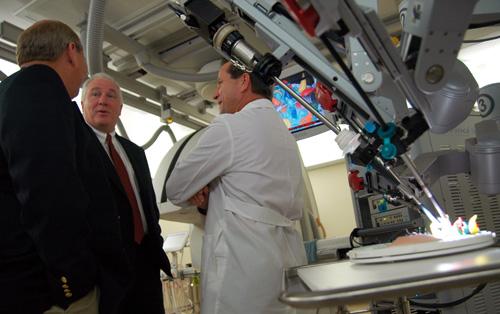Meet CU’s new robot surgeon: “da Vinci”
February 21, 2008
Carle Foundation Hospital unveiled the “da Vinci” on Wednesday, a state-of-the-art surgical robotic technology that will now be used to perform minimally invasive surgical procedures for men and women.
“Although it’s called robotic technology, that doesn’t mean it has a mind of its own,” said Dr. Reed Panos, chief of the department of surgery at Carle Hospital and medical director of surgical services for Carle Clinic.
Unlike Carle’s previous laparoscopic (open) surgery strategy, which utilized one camera and limited the surgeon’s vision to a two-dimensional view, the $1.5 million “da Vinci” is similar to an extension of a surgeon’s eyes and hands into the surgical field, according to a press release. It provides high definition, 3-D images of tissues and anatomy.
The system consists of a surgeon’s console, a patient-side cart with four interactive robotic arms and a high definition vision system.
Panos said they will begin using the “da Vinci” to perform three different surgeries: hysterectomies, the removal of a woman’s uterus; myomectomies, removal of a portion of the uterine wall; and prostatectomies, removal of the prostate.
Get The Daily Illini in your inbox!
“The system provides greater than twice the viewing resolution and 20 percent more viewing area,” Panos said. “This means improved detail and clairty, which is critical when performing delicate dissection or reconstructive procedures.”
Because the size of the surgeon’s hand is compressed to 1 1/2 centimeters wide, the surgical incisions are much smaller and patients will experience multiple benefits.
“In what before was a two to three night stay after a procedure, now is an overnight stay with faster recovery,” said Dr. Ron Konchanin, specialist in urology at Carle Clinic. “This really is unmatched by the human eye. The precision of the dissection is remarkable.”
As one surgeon sits at the console, his or her fingers grasp the master controls and mimic real movements of surgical instruments. The images displayed are magnified on a high-definition screen above the patient. A second doctor is also required for the surgery to carefully examine the actual patient and provide further directions.
While demonstrating how to use the “da Vinci,” Konchanin joked, “I’ve had 13 cups of coffee today and still no shakes.”
Although the “da Vinci” is not a new invention, patients will no longer have to travel outside of Champaign-Urbana to use the equipment.
Dr. Richard Wolf, a specialist in Urology at Carle Clinic, will be one of the first surgeons that will begin working at Carle Hospital with the “da Vinci.”
One in six men are diagnosed with prostate cancer and in 2007, out of the 90,000 prostatectomies performed, 60 percent were performed with the “da Vinci” robot, Dr. Wolf said.
“Everyone looks to Carle to lead in technology and care,” said Dr. Jim Leonard, president and CEO of Carle Foundation. “This is really an example of Carle stepping up as leaders to pursue cutting-edge treatments for our patients.” Leonard said that although Carle is only performing three different surgeries using the “da Vinici,” he expects doctors to be an active group in developing ways to carry out other procedures as well.
“We’ve only started to explore all the capabilities of this system,” Leonard said.







